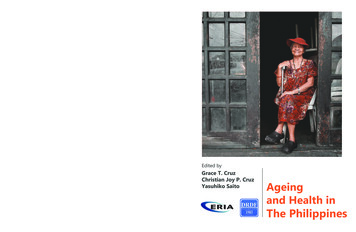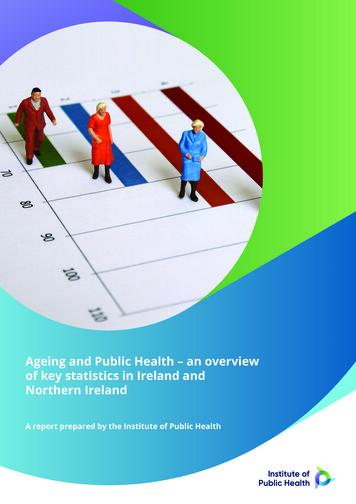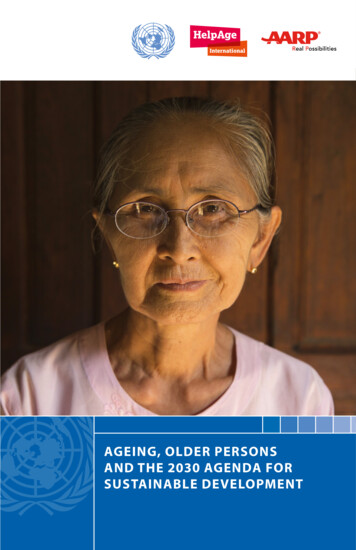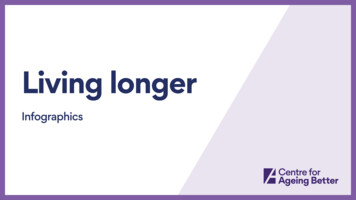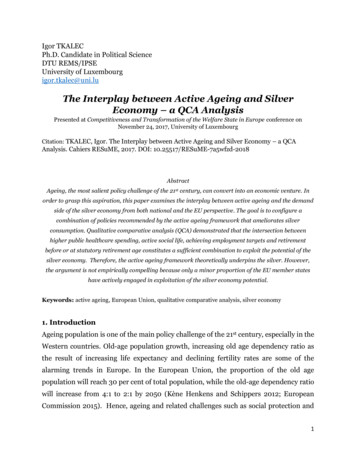
Transcription
Igor TKALECPh.D. Candidate in Political ScienceDTU REMS/IPSEUniversity of Luxembourgigor.tkalec@uni.luThe Interplay between Active Ageing and SilverEconomy – a QCA AnalysisPresented at Competitiveness and Transformation of the Welfare State in Europe conference onNovember 24, 2017, University of LuxembourgCitation: TKALEC, Igor. The Interplay between Active Ageing and Silver Economy – a QCAAnalysis. Cahiers RESuME, 2017. DOI: 10.25517/RESuME-7a5wfzd-2018AbstractAgeing, the most salient policy challenge of the 21st century, can convert into an economic venture. Inorder to grasp this aspiration, this paper examines the interplay between active ageing and the demandside of the silver economy from both national and the EU perspective. The goal is to configure acombination of policies recommended by the active ageing framework that ameliorates silverconsumption. Qualitative comparative analysis (QCA) demonstrated that the intersection betweenhigher public healthcare spending, active social life, achieving employment targets and retirementbefore or at statutory retirement age constitutes a sufficient combination to exploit the potential of thesilver economy. Therefore, the active ageing framework theoretically underpins the silver. However,the argument is not empirically compelling because only a minor proportion of the EU member stateshave actively engaged in exploitation of the silver economy potential.Keywords: active ageing, European Union, qualitative comparative analysis, silver economy1. IntroductionAgeing population is one of the main policy challenge of the 21st century, especially in theWestern countries. Old-age population growth, increasing old age dependency ratio asthe result of increasing life expectancy and declining fertility rates are some of thealarming trends in Europe. In the European Union, the proportion of the old agepopulation will reach 30 per cent of total population, while the old-age dependency ratiowill increase from 4:1 to 2:1 by 2050 (Kène Henkens and Schippers 2012; EuropeanCommission 2015). Hence, ageing and related challenges such as social protection and1
healthcare are at the top of the European Union’s policy agenda. For instance, theCommission considers the implications of ageing in the Europe 2020 Strategy as acomponent of sustainable and inclusive growth prospects. Understanding ageing as thesource and/or generator of economic growth is the result of the paradigmatic shiftregarding position and role of the elderly in an economy. The paradigm changed from the“elderly care” to “active citizenship” (Formosa 2017). In the period from the 1940s to the1980s, the policies concerning the old-age aimed to place the elderly outside the labourmarket as soon as possible while ensuring the income security through developingpension systems. In other words, the elderly were “cared for” (by the state). From the late1980s onward, there has been an effort to “re-integrate” the elderly in socio-economic life.This leaves us with a desirable scenario for the future in which the elderly are “activecitizens” fully included in socio-economic life (Walker and Maltby 2012; see also Walker2001 and 2006). Moreover, this scenario has the potential to utilise various economicopportunities created by ageing. The “active citizenship” is a synonym for active ageing, aconcept introduced by the World Health Organisation (WHO) in 2002. The active ageingpolicy framework appears to be one of the most streamlined responses to populationageing and its long-run economic, financial, and budgetary implications at the EU level.From an economic point of view, ageing unlocks new market opportunities. Theinteraction between the supply and demand side of the newly emerged and growingmarket with the elderly (60 ) as the targeted consumer group has been framed in the socalled “silver economy” concept. This paper examines the demand side of the “silvereconomy” in the EU. In particular, the paper explores the interplay between the “activeageing” framework as the mainstream policy response to ageing and the “silver economy”including the market opportunities that ageing processes convey. The research questionof this paper is the following: Under which conditions does the active ageing policyframework underpin the old-age consumption in the European Union? I deem theinteraction between the active ageing policy framework and silver economy as a setrelationship. Therefore, I use qualitative comparative analysis (QCA) to answer theresearch question empirically. This paper undertakes both national and an EU-wideapproach to the question at hand.2
The results demonstrate that the active ageing policy framework displays a strong subsetrelation with the silver consumption in the EU. Therefore, the framework is theoreticallyrelevant for turning ageing effects into economic ventures notably through utilising silvereconomy opportunities. Specifically, two policy combinations are sufficient for improvingsilver consumption. The first one encompasses higher public healthcare expenditure,retirement before or at the statutory age and socially active life in the old age includingactivity such as volunteering. The second combination comprises higher public healthcareexpenditure, socially active life in the old age (volunteering) and achieving nationalemployment targets of the member states. However, empirical support for a strong subset relation and theoretical relevance of active ageing framework for the silver economyis humble. Inclusion of only eight EU member states in the solution formula mirrors theclaim. In other words, the active ageing framework (as it is) is conducive for exploitingopportunities from silver economy, yet concrete policy actions aiming to achieve this goalare absent.The following two sections of the paper define the two key concepts of this study: activeageing and silver economy. The fourth section discusses the interaction between the two.The fifth section illustrates the methodological framework of this study. The sixth sectiondiscusses theoretical and empirical relevance of the findings. Finally, the conclusionsummarises the main arguments of the paper.2. Active ageingDue to lack of a precise and universally accepted definition (Walker and Maltby 2012),the concept of active ageing can be understood from numerous angles. In the broadestterms, active ageing is “the capacity of people as they grow older, to lead productive livesin society and the economy” (OECD 1998:84). To emphasize quality of life, the WHOoffers a more streamlined definition of active ageing and understands it as “the processof optimising opportunities for heath, participation and security in order to enhancequality of life as people age” (WHO 2002:24). The European Commission defines activeageing as “a coherent strategy to make ageing well possible in ageing societies” [thatincludes] “lifelong learning, working longer, retiring later and more gradually, beingactive after retirement and engaging in capacity enhancing and health sustainingactivities” (European Commission 2002:6). This paper adopts the Commission’s3
definition of active ageing, as it is seemingly the most suitable for the purposes ofcapturing both national and the EU angle in the empirical analysis.Active ageing and related themes have been present in the EU’s discourse since the 1990s.The first proclamation of the importance of active ageing was The European Year of OlderPeople in 1993 addressing the issue of generational solidarity. In 1999, conclusions fromthe EU Helsinki Summit gave eminence to ageing of the labour force and prospects foremployment of older workers. The Lisbon Council in 2000 took a decisive step to combatageing through economic policy by adopting a ten-year strategy for the EU to become amore competitive and knowledge driven economy. The ageing challenge was incorporatedinto strategy notably through employment. However, the strategy proved too ambitiousto, and has therefore been reiterated by the Commission under the Europe 2020 Strategy(Walker and Maltby 2012). The Europe 2020 Strategy encourages an inclusive growththat directly refers to ageing and its implications. Particularly, the “An agenda for newskills and jobs” flagship initiative incorporated into the Strategy, the EU aims to invest inskills, modernising labour markets, and ensure the sustainability of contemporary socialmodels (European Commission 2010).The EU has addressed population ageing and pursued the active ageing policy strategymainly through its economic dimension, notably employment. Ageing can generate bothjob creation and job loss trends example (see Schulz and Radvansky 2014). Moreover, theCommission introduced the Active Ageing Index (AAI), a comparative measure of policyoutcomes related to ageing. The AAI report from November 2014 illustrates a progress inpursuing active ageing policies in the majority of the member states comparing to 2012(EC 2014; see Zaidi 2015). However, a framed collaboration between different levels ofgovernance and actors such as businesses, regions, cities and consumers is still in an earlystage of development (Ahtonen 2012).In terms of economic effects of population ageing, the active ageing as a policy strategypermeates throughout four policy realms: pensions/retirement, employment, health andcitizenship (Walker 2001). The policy realms overlap with the Commission’s definition ofactive ageing. Moreover, they reflect the WHO’s economic dimension of active ageingincluding income, social protection and work as the main determinants (WHO 2002). Thefour policy realms reflecting economic effects of ageing (encompassed n the active ageingframework) are the core of the empirical analysis in this paper.4
3. Silver economyAs the active ageing concept, silver economy lacks universally accepted definition. TheEuropean Commission (2015:7) defines silver economy as “economic opportunitiesarising from the public and consumer expenditure related to population ageing and thespecific needs of the population over 50”. In addition, the OECD (2014:2) understandssilver economy as “an environment in which the over-60 interact and thrive in theworkplace, engage in innovative enterprise, help drive the marketplace as consumers andlead healthy, active and productive lives”.A portion of literature narrows the definition and focus to the consumption/demand sideof the silver economy. For instance, Zsarnoczky (2016) defines silver economy as a groupof senior people that is one of the most important in terms of buying power incontemporary economic environment.1 In addition, Schulz and Radwansky (2014)highlight the effects of ageing on the consumption structure and deem “silverconsumption” as an opportunity for specific sectors and small economies. The “silverconsumption” refers to households with a reference person older than 60 years of age. Incontrast, Štefánik et al. (2013:7) define silver economy as “a set of economic activitieslinked to the production of goods and services designed to target the elderly population”and therefore focus on the supply side of silver economy.2 This paper focuses on demandside of the silver economy.The motivation to study demand side of the silver economy is underpinned by statementthat “silver economy in an industry of the future that is worth discovering and developing”(Heinze and Naegele 2009:40). Five developments support this statement. Firstly,today’s old-age cohorts are relevant actors in private consumption whereas, in the past,they were neglected as private consumers. Secondly, the elderly are a heterogeneousgroup and thus will have differentiated consumption habits. This generates economicactivity and consequential growth in a range of economic sectors. Thirdly, today’s cohorts1Silver economy interlinks with numerous sectors in an economy. With ageing, new demand will penetrate themarket with specific needs and (ideally) with sufficient income and willingness to purchase supplied goods andservices. Some of the consumer segments include: media, smart home/real estate, tourism/medical tourism, homedelivery, recreation, local markets, home services etc. (see Zsarnoczky 2016).2Innovative products such as the Google Glass to assist people with Parkinson’s and Alzheimer’s disease or theFujitsu’s phone responsive to safety exemplify elderly-targeted products (OECD 2014, European Commission2015).5
of older people demand involvement in discussion concerning quality of life. In otherwords, they have become more active and engaged in socio-economic activities. Fourthly,senior citizens aim to preserve and increase independent living. Finally, the future ofsilver economy counts on “singularsation of old age”. The “singularsation” refers toincrease of small or one-person (old-age) households. This is particularly relevant fromthe economic point of view as the private demand continues to be governed byhouseholds, not by heads per household (Heinze and Neagele 2009). In the EU, the shareof households with a reference person over 60 years of age will increase from 36% in 2010to more than 43% in 2030. Similarly, total household consumption in the share of 60 years of age households will increase in the following decades (Schulz and Radwansky2014).3 In sum, the reasoning behind embracing ageing as an economic opportunity liesin the consumption potential of the increasing elderly population.Numbers, current value, and growth prospects of the “silver economy” buttress theoptimistic views on its full potential that is yet to be exploited. For instance, the wealthmanagement division of the Bank of America, Merrill Lynch (2014) estimates the value ofthe silver economy market to be approximately 7 trillion per year with the growthpotential of around 15 trillion by 2020, making it the third largest market in the world.In addition, Euromonitor estimates that the spending power of the “baby boomers” whohave been entering the 60 age cohort will reach around 15 trillion by 2020 globally.4Moreover, the SilverSUDEO5 project approximates the value of market for the “silvereconomy” at 420 billion (European Parliament 2015). Further exploitation of growthand consumption potential of the “silver economy” corresponds to goals of the activeageing policy framework. The flowing section discusses the interplay between the twoconcepts that will later serve as the core of empirical analysis.3.1. The interplay between active ageing and silver economy3Data and findings are the result of the NEUJOBS project (see cessed November 2017)4See Boomers as Consumers at port (accessed November2017)5See SEN@ER - Silver Economy Network of European Regions at http://www.silvereconomyeurope.org/network/about en.htm (accessed November 2017)6
This paper understands the interplay between the active ageing and the silver economyprimarily throughout a single magnitude – policy sectors. In particular, the interplay isembodied in the four above-indicated policy realms (pension/retirement, health,citizenship/participation, and employment). The policy realms constitute the core ofactive ageing policy framework and are the channels to combat population ageing with anoverarching aim to transform ageing from an unresolvable policy challenge into a socioeconomic venture. Silver economy, especially its demand side then would arise as theresult of the overarching aim. Not to mention, the Commission’s definition of activeageing directs a researcher to expect that all four policy realms positively affect demandside of the silver economy.The relevance of pension/retirement sector in relation to the silver economy demand(consumption) is undisputable. In the EU, public and/or private pensions cover almosttwo-thirds of the total income of the elderly (Pallares-Miralles, Romero, and Whitehouse2012).6 Two components are crucial in determining the final pension benefit: time spentin labour market (years of contributions to a pension scheme) and retirement age (seeWise 2006; Schwarz et al. 2014; Fox and Palmer 2001). In other words, employees shouldaim to stay employed longer in order to have a higher final pension. Nevertheless, theretirement systems in the EU suffer from the gap between the statutory retirement age(legally set age to claim full pension benefits) and effective retirement age (age at peopleactually start claiming (partial) pension benefits). According to the European UnionLabour Force Survey from 2012, more than 40 per cent of people retire prior to reachingthe statutory retirement age.7 Hence, if a person retires prior reaching the statutoryretirement age his/her pension will be lower. In contrast, if a person retires after he/shereaches the statutory retirement age and spends more years in the labour market, the finalpension will increase. As a response to both ageing and the retirement age gap, twelvemember states have implemented measures to “punish” early retirement by reduction of6See also Income Components Statistics index.php/Income components statistics; accessed April 2018) and Social Protection -explained/index.php/Social protection statistics; accessed April 2018)7See European Union Labour Force Survey - Eurostat at nunion-labour-force-survey (accessed April 2018)7
the final pension amount on a yearly basis.8 Contrariwise, the member states started to“award” late retirement ( European Commission et al 2015).According to the Commission’s definition of active ageing, citizenship/participationconstitutes the second policy realm relevant for pursuing the active ageing policies toexploit silver economy (see above). It includes political, social, cultural, and leisureactivities (WHO 2002, Walker 2002). One of the most prominent activity within thecitizenship sector is volunteering. Eurostat classified volunteering as one of the quality oflife indicators within the leisure and social interactions component.9 Volunteeringactivities enrich the life of the elderly by making them active and involved citizens andconsequently contribute to quality of life. Therefore, a higher level of involvement insocio-economic life may broaden consumption possibilities. Unfortunately, empiricalsupport for this statement is absent. However there is evidence that volunteering andparticipation in socio-economic life enhance the elderly’s well-being (see Oman et al.1999; Tabassum et al. 2016; Wheelock et al. 2009). Thus, volunteering acts as anintermediary between an active life and consumption drives. In other words, there is anindirect theoretical and rather than empirical expectation for the effects of volunteeringon silver consumption.Healthcare is the third realm for which the active ageing policy framework was expectedto have significant implications. Ageing is one the main drivers of increased healthcareand elderly long-term care expenditure (see Zweifel, Felder, and Meiers 1999; Dormontet al 2006; Smith, Newhouse, and Freeland 2009; Rechel et al. 2009; de Meijer et al.2013; OECD 2014). Increasing government healthcare expenditure is the result ofincreased demand for healthcare services coming from the elderly. The assumption isstraightforward – healthier elderly have the opportunity to live longer and active life andthus have more prospects for consumption.Employment, the fourth crucial policy sector within active ageing framework, is one themost prominent macroeconomic aggregates and immensely affects demand andconsumption (Blanchard 2010). As indicated in the literature review, the EU has8Austria, Belgium, Cyprus, Finland, France, Germany, Greece, Italy, Malta, the Netherlands, Slovakia, and SpainSee Quality of Life Indicators - Measuring Quality of Life - Statistics Explained d/index.php/Quality of life indicators - measuring quality of life(accessed November 2017)98
addressed the ageing challenge mostly with employment measures and targets. Asindicated, employment is a pertinent segment of the Europe 2020 Strategy with a targetof 75% for employment of the population aged 25-64. Correspondingly, nationalemployment targets were set across the EU member states (European Commission 2015).In sum, each of the four policy sectors is expected to have an impact on demand side ofthe silver economy. This paper aims to configure a combination of the four sectors thatameliorates the silver economy consumption rather than evaluate their independenteffects.4. MethodologyThree features distinguish qualitative comparative analysis (QCA) from other non-settheoretic methods: a) data consists of set-membership scores; b) relations between socialphenomena are modelled in terms of set relations (necessity/sufficiency); c) resultsemphasise causal complexity. There are two main types of QCA analysis – crisp and fuzzy.In contrast to crisp analysis where set membership scores are limited to 0 and 1, fuzzyanalysis allows for a partial set membership scores (any value between 0 and 1)(Schneider and Wageman 2012).Table 1 Operationalisation of conditions and the TCOMENOTATIONSilver consumption (60 age cohort)SCOPERATIONALISATION VARIABLEThe difference between effectiveretirement age and statutory retirementage% of the elderly participating ininformal volunteering activitiesGovernment expenditure on healthcareas % of GDPEU member states’ nationalemployment targetsOPERATIONALISATION VARIABLEConsumption of the elderly (60 ) perhousehold in PPS (purchasing powerstandards)Source: authorQCA aims at causal interpretation of different combinations of conditions in their absenceor presence and an outcome (Schneider and Wageman 2012), rather than evaluating neteffect of a single condition on the outcome – as practiced in, for example, regressionanalysis. In this paper, I analyse combinations of four conditions (income/retirement,citizenship/participation, healthcare, and employment) in respect to a single outcome(silver consumption) (see Table 1). The conditions embody policy sectors in which the9
active ageing policy framework has an impact according to the Commission’s definition.I perform fuzzy set QCA (fsQCA) analysis on the sample of 25 EU member states.10FsQCA requires the raw data (operationalisation variables) to be transformed into setmembership scores thorough the process of calibration (see Table 2). In the calibrationprocess, for three conditions (GAP, HE, and EMPT) I use a six-value fuzzy set calibration(Ragin 2008) whereas for the CIT condition and for the outcome SC I use a “continuous”fuzzy set calibration (Ragin 2008). Calibration criteria have been selected based on theliterature support, in-depth case knowledge and natural gaps in raw data, included in thesample (see Appendix 1).For the GAP (retirement/income) condition, I assign fuzzy scores according to“punishment/award” interaction described in the section 3.1. Therefore, theoperationalisation variable is the difference between are effective and statutory ages formales of the 25 EU member states for 2015. The main data source is the EuropeanCommission’s most recent Age Report (European Commission et al. 2015).11 Fuzzy scoreshigher than 0.5 represent a positive gap between the effective (the age at which a personactually retires) and statutory (legally set retirement age) retirement age whereas fuzzyscores lower than 0.5 represent a negative gap between the two. In other words, higherfuzzy scores indicate higher final pension benefit due to the longer stay in the labourmarket and more contributions to the pension scheme. In particular, a positive gap(retirement at least two years later than the statutory age) represents the threshold forfull membership in the GAP set/condition (score 1). The crossover point (score 0.5) equalsto retirement exactly at the statutory age. A negative gap (retirement at least two yearsbefore reaching the statutory age) signifies the threshold for full non-membership (score0) in the GAP set.In addition, I operationalise the HE (healthcare) condition with public spending onhealthcare as a proportion of GDP. Fuzzy scores higher than 0.5 represent higherThree EU member states are excluded from the empirical analysis – the United Kingdom, Croatia and Romania.The UK will soon leave the EU and it is therefore irrelevant for answering the research question. Croatia andRomania are excluded because of missing data for the citizenship condition in the QCA analysis. QCA as amethodological tool does not replace missing data (Ragin 2008; Schneider and Wagemann 2012).11I use the raw data for males because the EU member states are in the process of gradual equalisation of theretirement ages for men and women. In addition to aiming for equalizing the statutory retirement age for both menand women, there is a general trend of a gradual increase of the statutory retirement age among the member states,regardless of gender.1010
healthcare expenditure and are thus more in the HE set. In contrast, scores lower than0.5 represent lower healthcare expenditure and are more out of the HE set. I use threecriteria to calibrate qualitative thresholds (0, 0.5 and 1). The qualitative criteria includeWHO’s healthcare expenditure standards and healthcare spending categorizationsillustrated in the WHO’s Global Health Expenditure Atlas (2016). These have beensupported with quantitative clustering of raw data for the HE condition. In particular, thethreshold for full-non membership is the expenditure lower than 5% of GDP. Theexpenditure higher than 11% of GDP is the threshold for full membership in the HE set.The EU average expenditure (8.2-8.5%) serves as the crossover point. Eurostat was themain source for healthcare expenditure data (year 2015).12Moreover, in the attempt to capture an EU-wide perspective, I use data on the nationalemployment targets (for 2016) framed in the Europe 2020 Strategy (EuropeanCommission 2010) to operationalise the EMPT (employment) condition. I assigned thefuzzy thresholds (1, 0.5, and 0) according to successful and unsuccessful achievement ofpre-determined national employment targets. Fuzzy scores higher than 0.5 indicate closeto-successful (scores 0.6 and 0.8) or completely successful achievement of theemployment target (score 1) whereas fuzzy scores lower than 0.5 indicate far-fromsuccessful (scores 0.2 and 0.4) or completely unsuccessful national employment targetachievement (score ionfortheCIT(citizenship/participation) condition and for the outcome SC (silver consumption). The“continuous” fuzzy score calibration allows a case to have the values anywhere in the 0.0to 1.0 interval (see Ragin 2008). Operationalisation variable for the CIT condition is theproportion of the elderly (60 ) participating in informal volunteering organisations. I usequantitative clustering to identify natural gaps in raw data as the criterion to determinethe thresholds due to lack of qualitative evidence and universally accepted standards. Thethreshold for full membership (score 1) is 50%, the crossover point (score 0.5) equals to20% while the threshold for full non-membership (score 0) equals to 10%. I employEurostat’s most recent data (for 2010).In the case of Malta I used the WHO’s Global Health Expenditure Atlas (year 2016) because the Eurostat does notprovide data on Malta’s healthcare expenditure.1211
Finally, I “continuously” calibrate the outcome SC (silver consumption). The main datasource for the outcome was Eurostat’s EU-SILC survey most recent data (for 2010) forthe consumption of the elderly (above 60 year of age) per household expressed in PPS.13I apply in-depth knowledge on cases to assign full membership, non-membership andcrossover thresholds. In particular, I assign score 1 to Luxembourg and score 0 toBulgaria, Estonia and Latvia. The reasoning behind it consists of two developments thatare inevitably determine consumption capacity of the elderly: 1) at-risk of poverty rate ofolder people (60 ) and 2) aggregate replacement ratio (ARR).14 Luxembourg scores thehighest in the two measurements, whereas Bulgaria, Estonia and Latvia have the lowestscores in the sample. The scores for Bulgaria, Estonia and Latvia do not differ in asignificant amount in terms of the two measurements. Fuzzy scores above the 0.5crossover indicate higher consumption whereas scores below the 0.5 indicate lowerconsumption. The crossover point (0.5) equals to net median income in the EU for 2010.15Median income serves as a supplementary calibration tool external to raw data on silverconsumption and maps out overall purchasing power in the EU member states.After calibrating raw data for conditions and the outcome, I conduct the StandardAnalysis of sufficiency (SA) (see Schneider and Wagemann 2012:160-195) to inspect whatcombination of conditions is sufficient for the presence of the outcome. A condition (X)is sufficient for the outcome (Y) when it (X) is a subset of the outcome (Y).16 The statementof sufficiency implies that (fuzzy) membership scores in the outcome (Y) are higher orequal to (fuzzy) membership scores in condition (X) (Schneider and Wagemann 2012; seeAppendix 2 for fuzzy scores).13PPS (Purchasing Power Standards) - the standardisation and exchange mechanism between PPP (purchasingpower parity) and the euro. See Glossary: Purchasing Power Standard (PPS) - Statistics Explained /index.php/Glossary:Purchasing power standard (PPS) (accessed onNovember 2017).“The aggregate replacement ratio is gross median individual pension income of the population aged 65–74relative to gross median individual earnings from work of the population aged 50–59, excluding other s
into strategy notably through employment. However, the strategy proved too ambitious to, and has therefore been reiterated by the Commission under the Europe 2020 Strategy (Walker and Maltby 2012). The Europe 2020 Strategy encourages an inclusive growth that directly refers to ageing and its implications. Particularly, the "An agenda for new


